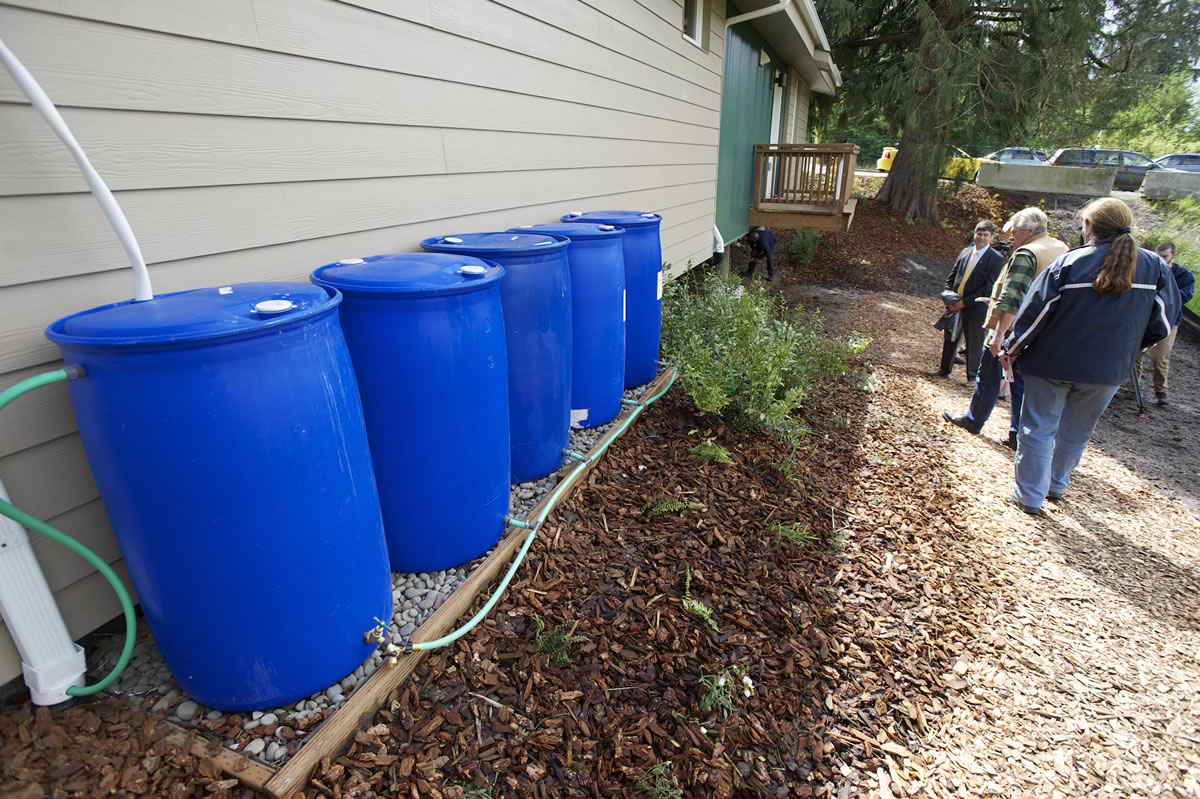In Pacific Northwest fashion, a downpour welcomed the newly finished emerald house at 9717 N.E. 25th Ave. Volunteers and visitors huddled inside to admire the energy-efficient features of Evergreen Habitat for Humanity’s newest addition.
The rain, meanwhile, ran off the metal roof, down the gutters and into five 55-gallon barrels used to water the landscape and blueberry plants in the backyard.
The stormwater management system is just one of many green features at the Planet Clark Emerald House that opened for public tour Friday afternoon. Volunteers worked to the last minute to get the house ready, installing marboleum flooring through lunchtime.
The single-story house still needs some finishing touches, with room reserved for a solar panel. But, it’s on track to earn the Emerald designation by the National Association of Home Builders, the highest green rating the organization gives out, similar to the separate Leadership in Energy and Environmental Design (LEED) scale. The $129,000 project uses 60 less water and electricity than a typical home, according to the county.
“All our houses incorporate some sustainable building, but not to the extent of this,” said Josh Townsley, executive director of Evergreen Habitat for Humanity. “This is the future.”
South-facing windows and specially insulated wall and roof panels help keep the house warm when it’s cool outside. Overhangs and awnings over the south and west windows provide cooling shade for summer. Sealing around outlets and plumbing improves energy efficiency and air quality. Water supply outlets are clustered around the water heater, resulting in less water and energy waste. The shower, the toilet and the sinks — all low-flow structures — are within 6 feet of the heater. Aside from the refrigerator and stove, the house contains all LED lighting.
It’s small details rather than robust technologies that contribute to the home’s high performance.
The project was a learning experience for volunteers and the 30 partners involved in its conception — but that was the point. The project provides a real-life example of green building that local developers can learn from, not just for its sustainability, but also for its accessibility.
New homeowners Sheri and Dennis Ziesemer applied for a Habitat for Humanity home because their rental in Camas can’t accommodate Sheri’s disabilities. Eight years ago, she was diagnosed with multiple sclerosis, commonly known as MS, which affects her balance, movement and even standing at times. The steps and uneven floors made getting around a challenge. Although they downsized, the Emerald Home maximizes the space with an open floor plan, flat entryway and a walk-in shower with grab bars.
“We didn’t think we were going to get it,” Dennis Ziesemer said of the home. Dennis, a self-employed home designer, said financial struggles and health issues made it seem like the family continually faced hurdles. After being diagnosed with Stage III colon cancer, Dennis went through treatment and chemotherapy. The cancer is now in remission.
When the organization asked to interview the family for a home, he was blown away, and the family went to work blowing down those hurdles. The Ziesemers put in more than 1,200 hours of volunteer “sweat equity” with Habitat for Humanity over the last year and a half.
Sheri Zeisemer slowly stood up from her walker at the home’s dedication and looked at the crowd of volunteers with watery, beaming eyes. “If I could write a letter and tell each one of you how thankful I am, I would.”
Before the groundbreaking in October 2012, there was a vacant run-down house that attracted transients to the site. One remnant of the former, dilapidated lot remains. Wooden window sills were crafted out of a cherry tree that had to be chopped down during construction.
While the home aims to be Clark County’s first Emerald home, there are LEED-certified buildings already in the area. People looking to build a new home could take tips from the green practices in place and work with architects to ensure their home earns green certification.
The Emerald House is a compact, 1,154 square-foot home, which reduces the amount of building materials and future utility costs, said architect Timothy Buckley. Efficient placement of the water heater and a low-maintenance yard cuts down on resource use, a benefit that extends beyond property lines.
When you don’t put as much strain on the infrastructures — power, water, sewage — that support communities, it allows for growth, said Mike Selig with the Department of Community Development. High-performance homes make room for more residences when the environmental footprint is smaller.
Homeowners can find ways to improve their home’s efficiency without dramatically changing the structure. Clark Public Utilities customers can get free energy audits at the their home to learn where their bill is going and where there may be waste.
Sealing the areas around outlets and plumbing, as well as swapping out toilets and shower heads for low-flow fixtures, can add up over time. Those rain barrels in the backyard? You can make one for about $20.
Patty Hastings: 360-735-4513; patty.hastings@columbian.com.




